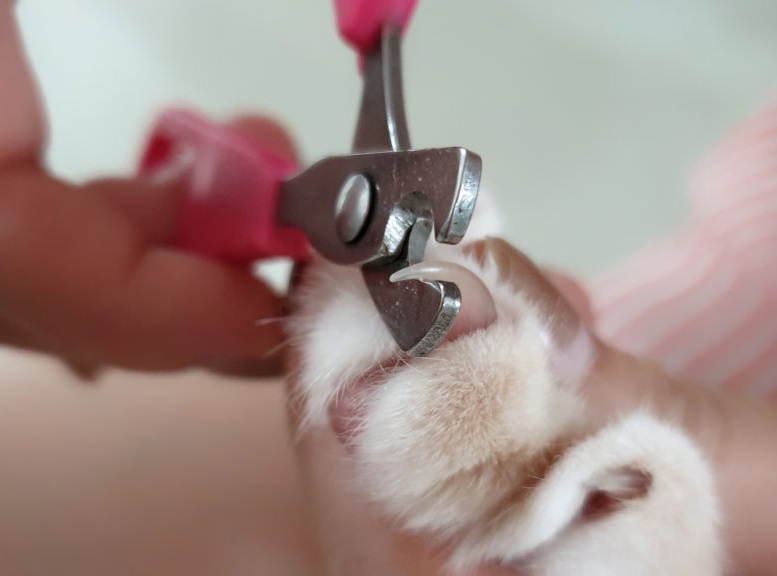Declawing a cat is a controversial procedure that can have lasting effects on a cat’s physical and psychological well-being. Many veterinarians and animal advocates discourage the practice due to the potential pain, health complications, and behavioral changes it can cause in cats. Here’s a look at the pros and cons of declawing and some recommended alternatives that help maintain both your cat’s and your home’s well-being.
Affiliate Disclaimer: This post may contain affiliate links and we may earn a small commission when you click on the links at no additional cost to you so we can continue to provide you with helpful tips and tricks. As an Amazon Affiliate, we earn from qualifying purchases. Thank you for supporting our small business.
What is Declawing?
Declawing, or onychectomy, is a surgical procedure in which a cat’s claws and the last bone of each toe are removed. While some may consider it a solution for preventing furniture damage or scratches, declawing can have serious implications for cats’ health and quality of life.
Pros of Declawing
-
Furniture and Belongings Protection
Declawing can prevent cats from scratching and damaging furniture or household items, which may help maintain a tidy and clean home environment. -
Reduced Scratching-Related Injuries
Declawing may prevent accidental scratches, which can be a concern for those with compromised immune systems. However, many experts recommend safer alternatives to address scratching concerns.
Cons of Declawing
-
Pain and Long-Term Discomfort
Declawing is a painful surgery that removes bone, nerves, and ligaments. Many cats experience significant post-operative pain, and some suffer from long-term issues like nerve damage and arthritis, which can affect their mobility and overall comfort. -
Behavioral Changes
Without claws, cats may experience stress and insecurity, leading to increased aggression or biting as they lose a primary defense mechanism. This behavior change can make them more challenging to handle or live with and can impact their quality of life. -
Physical Health Risks
After declawing, many cats develop musculoskeletal problems due to changes in their gait and posture. This procedure can also affect their balance, making everyday activities and movements more painful or difficult over time. -
Growing Bans and Veterinary Opposition
Due to the negative impact of declawing, numerous cities and states across the U.S. have passed bans or restrictions on the procedure. Organizations like the American Veterinary Medical Association (AVMA) advise against it unless absolutely necessary, as there are alternative ways to handle scratching behavior.
Safer Alternatives to Declawing
If scratching is a concern, there are effective products and techniques to manage your cat’s natural behavior without harming their health.
-
Scratching Posts and Pads
Providing ample scratching surfaces can help redirect your cat’s scratching away from furniture. Cats have a natural instinct to scratch, and a designated scratching area can satisfy this urge.-
SmartCat Pioneer Pet Ultimate Scratching Post: This sturdy, tall post is made from sisal, which many cats find irresistible. Available on Amazon.
-
Catit Style Scratcher with Catnip: A budget-friendly cardboard scratcher that comes with catnip to attract cats and provide a satisfying scratching surface. Available on Amazon.
-
-
Cat Nail Trimmers
Regular nail trimming can significantly reduce scratching damage without harming your cat. Establishing a nail-trimming routine can make the process easier over time.-
Safari Professional Cat Nail Trimmer: This easy-to-use trimmer is a top choice for cat owners looking for a safe way to maintain their cat’s nails. Available on Amazon.
-
JW Pet GripSoft Cat Nail Clipper: These nail clippers feature a comfortable grip for easy handling, making nail maintenance a breeze. Find it on Amazon.
-
-
Soft Nail Caps
Nail caps are a safe and humane alternative to declawing. They are small, soft caps glued onto a cat’s claws to prevent them from scratching surfaces while still allowing normal movement.- Soft Claws Cat Nail Caps: These non-toxic, easy-to-apply nail caps offer a temporary and painless solution to scratching, lasting several weeks per application. Check it out on Amazon.
-
Furniture Protectors
Adhesive strips and couch guards protect furniture surfaces while deterring cats from scratching.- Sticky Paws Furniture Strips: Clear, safe strips that create a texture cats dislike, helping keep furniture scratch-free. Available on Amazon.
Conclusion: Prioritizing Your Cat’s Well-Being
Declawing is a painful, invasive procedure that often leads to long-term pain, behavioral issues, and health problems for cats. With the array of alternatives available—from scratching posts to nail caps—pet owners have many safe, effective options to manage their cat’s scratching. Taking these humane approaches helps keep both your home and your cat safe, comfortable, and happy.


